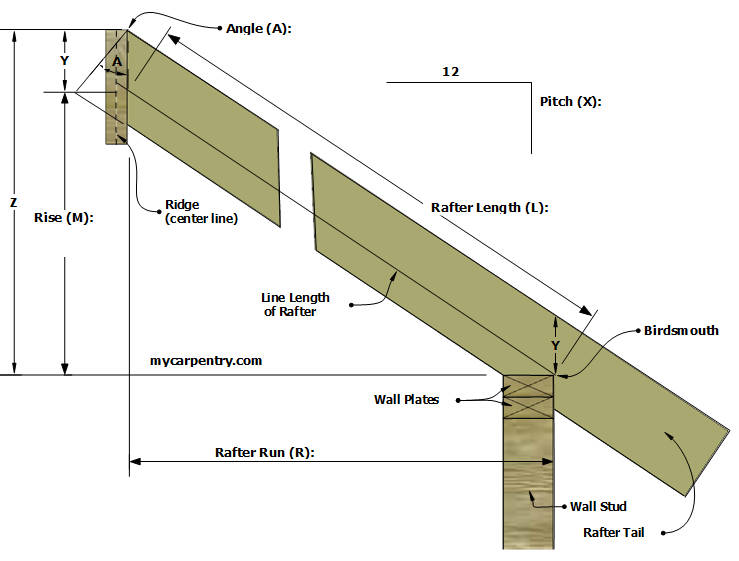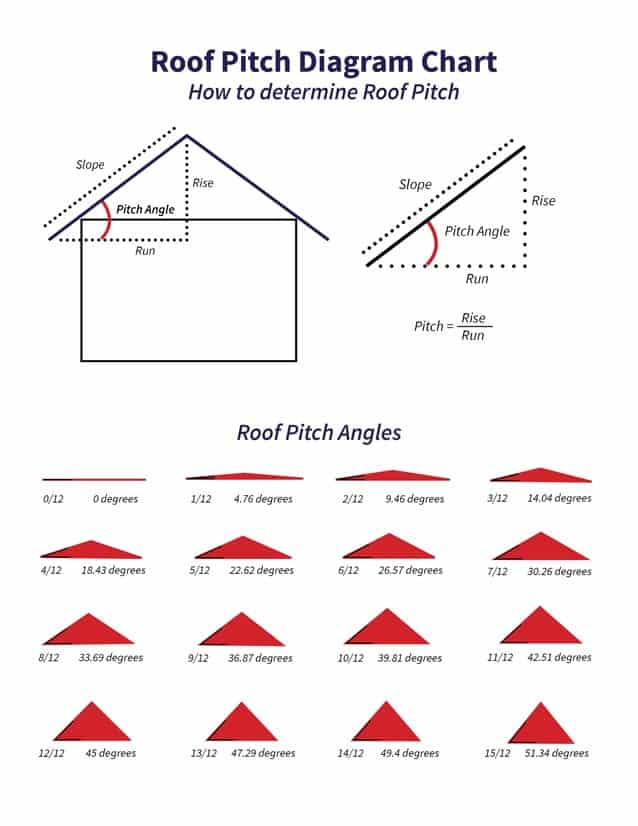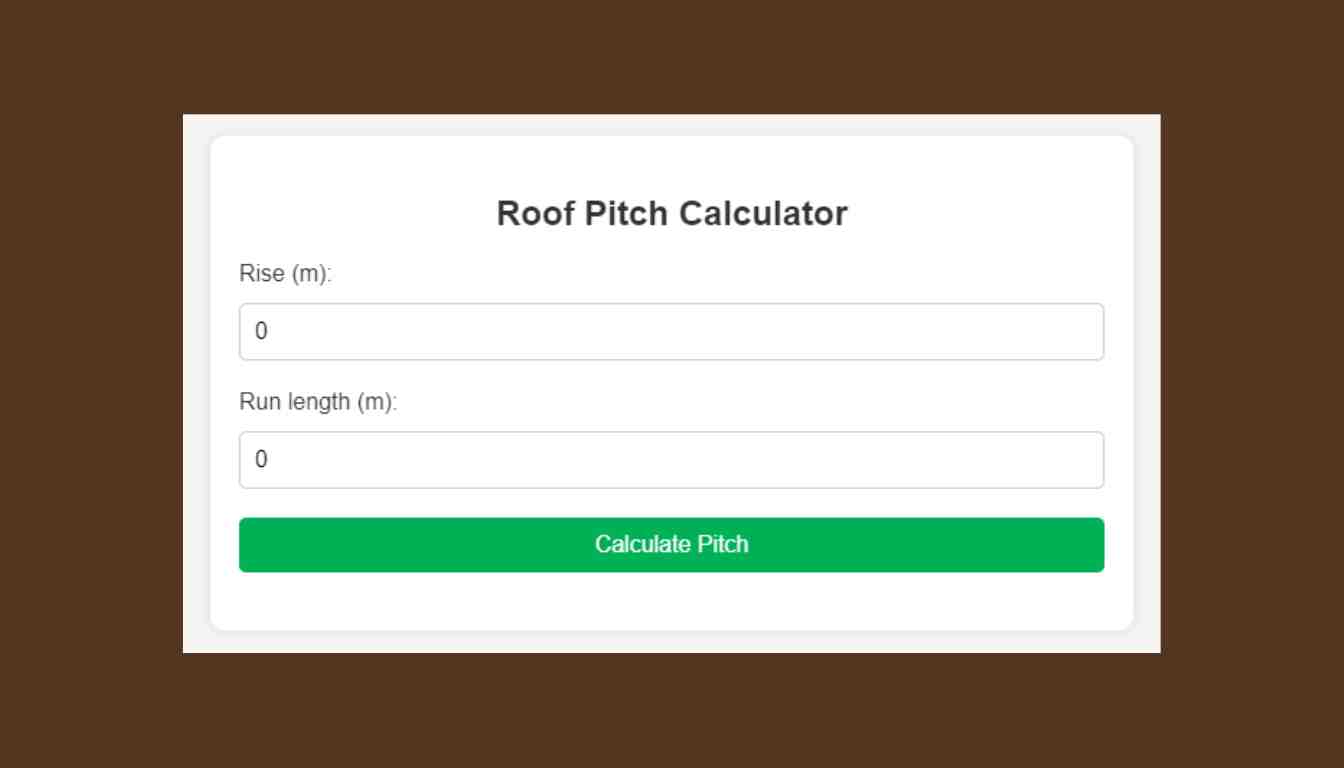A roof pitch calculator helps determine the angle of your roof’s slope. Simply input the rise and run to get your pitch value.
Roof Pitch Calculator
Understanding the pitch or slope is crucial for both new construction and renovations, ensuring that roofing materials match the incline and that water runoff is properly managed. The calculation of roof pitch is indispensable for architects, builders, and homeowners making decisions about appropriate roofing materials, gutters, and the aesthetic appeal of the house.
A proper roof pitch calculation ensures that your structure complies with local building codes and withstands weather conditions, avoiding costly repairs due to water damage or structural issues. The calculator streamlines the design process and aids in effective project planning and execution, enhancing the functionality and longevity of your roofing system.

Credit: www.mycarpentry.com
Introduction To Roof Pitch Calculators
Understanding the slope of your roof is essential for many home improvement projects. A roof pitch calculator simplifies this process, offering a quick and accurate method to determine your roof’s incline. With user-friendly interfaces, these calculators promote precision in construction and renovation tasks.
The Importance Of Accurate Roof Pitch Measurement
Determining your roof pitch with accuracy is crucial. The correct pitch ensures:
- Proper water runoff, preventing leaks.
- Correct material estimates, saving costs.
- Compliance with building codes.
Accuracy affects not just functionality but also the safety and longevity of your roof.
Common Uses For Roof Pitch Calculators
Professionals and DIY enthusiasts use roof pitch calculators for:
- Designing custom roofs.
- Calculating the area for shingles or tiles.
- Preparing installation of skylights.
- Aligning satellite dishes optimally.
These tools streamline planning and enhance the execution of roofing projects.
Basics Of Roof Pitch
A roof pitch calculator is a handy tool used by builders, roofers, and DIY enthusiasts. It helps to determine the slope of a roof. Understanding roof pitch is crucial for proper construction and rainwater drainage.
What Is Roof Pitch?
Roof pitch refers to the steepness or incline of a roof. It’s a measurement of how high the roof rises over a set horizontal distance. Roof pitch affects style, drainage, and the materials used for the roofing.
How Is Roof Pitch Expressed?
Rooftop pitch comes as a ratio. This ratio represents rise over run. The rise is the roof’s vertical height. The run is the horizontal span. For example, a pitch of 4:12 means the roof rises 4 inches for every 12 inches of run.
To visualize this better, here’s a table:
| Pitch Ratio | Rise (inches) | Run (inches) |
|---|---|---|
| 4:12 | 4 | 12 |
| 6:12 | 6 | 12 |
Note: Steeper roofs (higher pitch) may require more materials and labor.
Pitch affects a roof’s design. Low-pitched roofs are common in modern architecture. Traditional homes may have steeper pitches. Each pitch type suits different materials and weather conditions.
- Flat Pitch: Not actually flat but has a very low slope.
- Low Pitch: Easier to walk on and requires fewer materials.
- Steep Pitch: Offers more attic space and sheds snow and water quickly.
By understanding the basics of roof pitch, you can make informed decisions for your roofing projects. A roof pitch calculator simplifies this technical aspect so you can focus on creating a durable and aesthetically pleasing roof.
Types Of Roof Pitch Calculators
Finding the right roof pitch is a crucial step for safe and efficient roofing projects. A roof pitch calculator helps professionals and DIY enthusiasts alike determine the angle of their roof with precision. These handy tools come in various forms, each with unique features suitable for different needs. Below, we explore the two main categories: digital and manual calculators.
Digital Vs. Manual Calculators
The choice between digital and manual roof pitch calculators often depends on personal preference and project needs. Digital calculators offer quick and accurate measurements with just a few clicks. They come as mobile apps or online tools. In contrast, manual calculators are physical tools like the traditional protractor or angle finder. They require hands-on use and understanding of how to read angles.
Digital Calculators:
- Quick results
- User-friendly interfaces
- Options for saving and sharing results
Manual Calculators:
- No need for batteries or power
- Durable and long-lasting
- Can be used without internet access
Popular Tools And Apps
In the realm of digital calculators, several tools and apps have gained popularity due to their ease of use and reliable features. Most of these apps are available on smartphones, making them handy for on-site calculations. Some popular digital options include:
| App Name | Features |
|---|---|
| Roof Pitch Finder | Stores multiple project pitches, photo integration |
| Pitch Gauge | 3D roof visualization, GPS-based pitch detection |
| Roofing Calculator | Material estimates, customizable settings |
Users seeking simple and tangible tools might turn to manual calculators. One highly regarded manual tool is the angle finder, often used in conjunction with a level for accuracy. Among its characteristics are:
- Portable
- No technological know-how needed
- Functional in various environments

Credit: www.pinterest.com
Measuring Roof Pitch
Discover the ease of determining the incline of your roof with our Roof Pitch Calculator. This convenient tool quickly translates roof measurements into degrees, ensuring precise and efficient project planning.
Measuring Roof Pitch
Understanding your roof’s pitch is crucial for repairs and replacements. A roof pitch calculator simplifies this process. Knowing your roof pitch helps in selecting the right materials. Let’s dive into how to measure your roof’s pitch accurately.
Tools You’ll Need
To measure the pitch of your roof, you’ll need specific tools:
- Ladder – To safely reach your roof.
- Level – A 12-inch level is ideal for accuracy.
- Tape Measure – For distance measurements.
- Calculator – To calculate the pitch.
- Notepad and Pen – To record your findings.
Step-by-step Measurement Process
Follow these steps to measure your roof’s pitch:
- Climb Safely – Set up your ladder securely.
- Place Level – On the roof, hold your level flat.
- Measure the Rise – Note 12 inches on your level.
- Record the Rise – From the 12-inch mark, measure vertically up to the underside of the roof. Write this number down.
- Use Roof Pitch Calculator – Enter the rise over a 12-inch run into the calculator to get your pitch.
Remember: Steeper roofs have higher pitch values. Safety is paramount; never measure alone. Now, you have your roof pitch ready for planning any project!
Converting Roof Pitch
Understanding the angle of your roof is crucial for many home improvement projects. From installation of solar panels to replacing shingles, knowing your roof’s pitch is key. Roof pitch determines the steepness of your roof. It often comes in two numbers, like 4/12 or 6/12. These figures can be tricky to understand. That’s where converting roof pitch comes in handy. Let’s learn how to translate these numbers for better planning and execution of your roofing projects.
From Degrees To Pitch
Roofs can also have their steepness described in degrees. It’s like a protractor reading. To convert degrees to a pitch format, you’ll need a roof pitch calculator. If you’re doing it manually, the math involves tangent functions from trigonometry. A 45-degree roof equals a 12/12 pitch. This means for every 12 inches of run, there’s a 12-inch rise. Here’s a simple table to make things clearer:
| Degree | Pitch |
|---|---|
| 15° | 4/12 |
| 30° | 7/12 |
| 45° | 12/12 |
Calculating Roof Slope
To calculate roof slope without degrees, grab your ladder and measuring tape. You need to identify the rise over a 12-inch run, which is the horizontal distance. Measure 12 inches along the horizontal line of the roof. Then, measure vertically from the end of this line to the roof. Write down these two numbers. The vertical measure is your rise, and your run is always 12 inches. This ratio is your slope. For a more precise number, consider a digital roof pitch calculator.
- Measure 12 inches (run) along the roof’s horizontal line.
- Measure from the end of this line up to the roof (rise).
- Your roof’s pitch = Rise/Run.

Credit: roofvents.com
Calculating Roof Area With Pitch
Knowing your roof’s precise area is vital for many reasons. From material estimates to insulation needs, accurate calculations ensure efficiency and cost-effectiveness. The pitch of the roof affects its actual surface area, making it important to adjust calculations accordingly. This section will simplify the process of calculating roof area by considering the pitch.
Adjusting For Pitch In Area Calculations
Measuring a roof’s area is not just about length and width. Pitch creates an additional dimension to consider. To find the true surface area, the pitch factor, a multiplier derived from the roof’s angle, is used.
Here is a simple way to adjust for pitch:
- Calculate the footprint area (length x width).
- Determine the pitch of the roof (rise over run).
- Use a pitch factor chart to find the corresponding multiplier.
- Multiply the footprint area by the pitch factor.
The result provides the roof’s true surface area.
| Pitch | Pitch factor |
|---|---|
| 4/12 | 1.054 |
| 6/12 | 1.118 |
Case Studies: Different Roof Shapes
Different roof shapes have unique challenges. Peaked and hipped roofs offer different surfaces to measure.
A-frame roofs, for example, consist of two equal-size slopes:
- Measure one side.
- Double the result for the total area.
With hipped roofs, varying pitches might be involved:
- Determine the area for each plane.
- Adjust each plane’s area with its pitch.
- Sum these areas for the total.
Following these steps ensures that no detail is missed and you get accurate materials for your roof.
Factors Affecting Roof Pitch Choice
Deciding on a roof pitch involves several considerations. Factors vary from climate conditions to the specific architectural style of a home. A roof pitch calculator helps homeowners and builders determine the right angle. Each factor plays a crucial role in ensuring the roof’s effectiveness and visual appeal. Let’s explore the primary factors influencing this important decision.
Climate Considerations
Climate is a key determinant in selecting the right roof pitch. Different weather patterns demand different roof slopes for optimal performance. Here’s how climate influences roof pitch:
- Heavy Snowfall: Steeper pitches reduce snow accumulation to prevent damage.
- High Rainfall: A moderate to steep pitch allows quicker water runoff, reducing leakage risks.
- Wind: Areas with strong winds may require lower pitches to maintain stability.
Architectural Styles
The architectural style of a home can dictate the pitch of the roof. The chosen angle often complements the design aesthetics. Refer to the table below for common styles and their typical pitches:
| Style | Typical Roof Pitch |
|---|---|
| Cottage | Steep pitches for a quaint, cozy appearance |
| Ranch | Low to moderate pitches for a sprawling effect |
| Modern | Flat to low pitches for a sleek, minimalist look |
Each architectural design has a complementary roof pitch that enhances its characteristics. The right pitch adds both functionality and beauty to the structure.
Tips For Using Roof Pitch Calculators
Understanding the slope of your roof is essential for many construction and maintenance projects. Roof pitch calculators make this task easier. Let’s explore crucial tips to enhance your calculations’ effectiveness.
Avoiding Common Errors
Roof pitch calculators are handy tools. Yet, simple mistakes can lead to costly misjudgments. Consider these points to avoid errors:
- Input accurate measurements: Ensure you double-check the numbers you feed into the calculator.
- Check the units: Confirm whether you’re using feet, meters, inches, or centimeters and stick to one system.
- Validate the pitch angle: Ensure the angle represents a slope, not the actual length of the roof.
- Review results: Compare your calculator results with manual calculations for consistency.
Accuracy And Precision Tips
Maintaining accuracy and precision is crucial. Apply these tips for accurate measurements:
- Use quality tools: Invest in reliable measuring tapes or laser distance measurers for initial data collection.
- Calibrate your tool: Regularly check that your calculator is up-to-date and accurately calibrated.
- Document measurements: Keep a record of your measurements and calculations to refer back to or adjust as needed.
- Consult professionals: When in doubt, seek advice from experienced roofers or architects.
Beyond Calculation: Installing A Roof With Proper Pitch
Understanding roof pitch is vital for a sturdy, weather-resistant home. It’s not just a number. It ensures water runoff, structural integrity, and aesthetic appeal. A roof pitch calculator helps homeowners and builders determine the right angle. But, what comes after calculation is crucial. You have to select materials and decide who will install the roof. Let’s dive into these important steps.
Selecting Materials For Pitched Roofs
Choosing the right materials is key for a pitched roof. They affect durability, maintenance, and your home’s look. Consider factors like climate, house style, and weight. Asphalt shingles and metal roofing are popular choices due to their resilience and variety. Below are preferred materials:
- Asphalt Shingles: Cost-effective and easy to install.
- Metal Roofing: Long-lasting and reflects the sun’s heat.
- Wood Shakes: Offers a natural look with decent insulation.
- Slate Tiles: A high-end option, known for its longevity.
- Concrete Tiles: Strong and can mimic other materials.
Professional Installation Vs. Diy
Installing a roof takes skill. The choice between professional installation and DIY can impact your roof’s quality. Professionals come with experience, tools, and warranties. DIY, on the other hand, can be risky but may save money. Review the comparison:
| Professional Installation | DIY Installation |
|---|---|
| Expert-level quality | Potential for errors |
| Access to better materials | Limited to readily available options |
| Warranty on workmanship | No professional warranties |
| Faster completion | May take more time |
| Job safety assurance | Safety risks involved |
Frequently Asked Questions On Roof Pitch Calculator
What Is A Roof Pitch Calculator?
A roof pitch calculator is a tool that determines the slope or angle of a roof. It takes horizontal run and vertical rise measurements to calculate the pitch. This tool simplifies roofing projects and ensures accuracy in measurements.
How Does Roof Pitch Affect Building Design?
Roof pitch directly influences the aesthetic and functionality of a building. Steeper pitches can shed water and snow more effectively. They may also provide more attic space or allow for vaulted ceilings within the structure.
Can I Calculate Roof Pitch From The Ground?
Yes, you can estimate roof pitch from the ground using a level and measuring tape to assess the roof’s rise over a 12-inch run. However, for precision, a roof pitch calculator or professional assessment is recommended.
What Units Does A Roof Pitch Calculator Use?
Roof pitch calculators typically use degrees for angles or a ratio of inches per 12-inch run (rise/run). This tool may provide results in both units for versatility in roofing applications.
Conclusion
Navigating roof calculations has never been simpler. Our Roof Pitch Calculator equips you with the precision you need, saving time and resources. Let’s take the guesswork out of roofing—a reliable project starts with accurate measurements. Embrace confidence in your next build; start calculating now.


